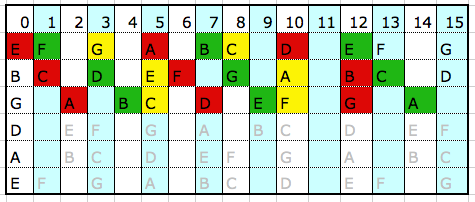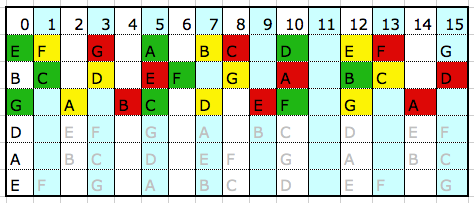3. Basic Chords
Page 1 of 1
 3. Basic Chords
3. Basic Chords
TRIADS:
Triads are the simplest chords. They contain three notes. There are four main triads:
Augmented (Root/M3/#5) – denoted “C+”
Major (Root/M3/5) – denoted “C”
Minor (Root/m3/5) – denoted “Cm”
Diminished (Root/m3/b5) – denoted “C°”
(A “#5” is the same distance as a “m6”, and a “b5” is the same as a tritone or “#4”. They are called “5”s in some instances because they are on the 5th letter of the scale.)
Another thing worth noting is the intervals between the notes of chords.
A major triad is a "1 -(up a Maj3)-> M3 -(up a min3)-> 5"
min triad "1 -(m3)-> m3 -(M3)-> 5"
dim triad "1 -(m3)-> m3 -(m3)-> b5"
aug triad "1 -(M3)-> M3 -(M3)-> #5"
DIATONIC CHORDS:
Chords are called “diatonic” if all their notes fall in the scale you’re playing in. Every note in a scale has a diatonic triad starting on it. They are made by skipping over ever other note in the scale. For example for C major (C-D-E-F-G-A-B-C) has Cmaj (C-E-G), Dmin (D-F-A), Emin (E-G-B), Fmaj (F-A-C), Gmaj (G-B-D), Amin (A-C-E), and Bdim (B-D-F). These chords would also be diatonic in any of C major’s relative modes.
In a major scale the diatonic triads always follow this pattern (Maj-min-min-Maj-Maj-min-dim). By the same token, a natural minor’s diatonic triads are always (min-dim-Maj-min-min-Maj-Maj). Same order starting in a different spot.
INVERSIONS:
Triads don’t always have to go 1-3-5. The 3rd can be in a lower octave, for example. Different orders of the same notes are called “inversions”. A triad that goes 1-3-5 is said to be in its “root inversion”, 3-5-1 is the “first inversion”, 5-1-3 is the “second inversion”. Each inversion has a slightly different voice. You can use inversions to make the notes of two chords closer together, thus making the transition smoother. You can also switch inversions with repetitions of a chord progression for some variation.
TRIADS APPLIED TO GUITAR:
Once you have some book knowledge on triads, the next step is playing with them and seeing how they work on an instrument. Triads are relatively simple and once you have a decent grasp on them, chords beyond them don’t seem as strange as they used to.
For this exercise, we’ll just use the three highest strings on the guitar. When you start to memorize the positions of the triads in the major scale, you can do a lot with just those three.
To start off easy, let’s examine C major. (C-D-E-F-G-A-B-C)
Here are where all the notes in C major occur on the fretboard:

These are the diatonic triads of C major:
C (C-E-G)
Dm (D-F-A)
Em (E-G-B)
F (F-A-C)
G (G-B-D)
Am (A-C-E)
B° (B-D-F)
In the root inversion (1-3-5), here are where those triads occur:

In this inversion, the root is on the G string, the 3rd is on B, and the 5th is on E.
Notice all the major chords (C, F, & G) are in the same pattern. Same for the minors. First inversion diminished chords always follow a pattern too.
Practice going up and back down the scale playing these triads. Once you have a pretty good feel for the pattern, move on to the first inversion.
Here are where the 1st inversion (3-5-1) triads fall:

Now the root is on E, the 3rd on G, and 5th on B.
Again all majors and minors follow a pattern.
Practice going up and down the scale with the triads like you did with the root inversion. Once you have this one down too, try ascending with one inversion and descending with the other. Or just start messing around and seeing what triads sound good together. Mix it up, then move to the second inversion.
Here’s where the 2nd inversion (5-1-3) triads are:

So that’s it. All 7 major scale triads, in all 3 inversions. There are really only 9 finger configurations you need to remember. The chord patterns are always the same for any major scale or relative mode, they just start at different spots.
The examples above are also the diatonic triads for D Dorian, E Phrygian, F Lydian, G Mixolydian, A minor, and B Locrian. Mess around with chord progressions focusing around different notes to explore the modes more.
Triads are the simplest chords. They contain three notes. There are four main triads:
Augmented (Root/M3/#5) – denoted “C+”
Major (Root/M3/5) – denoted “C”
Minor (Root/m3/5) – denoted “Cm”
Diminished (Root/m3/b5) – denoted “C°”
(A “#5” is the same distance as a “m6”, and a “b5” is the same as a tritone or “#4”. They are called “5”s in some instances because they are on the 5th letter of the scale.)
Another thing worth noting is the intervals between the notes of chords.
A major triad is a "1 -(up a Maj3)-> M3 -(up a min3)-> 5"
min triad "1 -(m3)-> m3 -(M3)-> 5"
dim triad "1 -(m3)-> m3 -(m3)-> b5"
aug triad "1 -(M3)-> M3 -(M3)-> #5"
DIATONIC CHORDS:
Chords are called “diatonic” if all their notes fall in the scale you’re playing in. Every note in a scale has a diatonic triad starting on it. They are made by skipping over ever other note in the scale. For example for C major (C-D-E-F-G-A-B-C) has Cmaj (C-E-G), Dmin (D-F-A), Emin (E-G-B), Fmaj (F-A-C), Gmaj (G-B-D), Amin (A-C-E), and Bdim (B-D-F). These chords would also be diatonic in any of C major’s relative modes.
In a major scale the diatonic triads always follow this pattern (Maj-min-min-Maj-Maj-min-dim). By the same token, a natural minor’s diatonic triads are always (min-dim-Maj-min-min-Maj-Maj). Same order starting in a different spot.
INVERSIONS:
Triads don’t always have to go 1-3-5. The 3rd can be in a lower octave, for example. Different orders of the same notes are called “inversions”. A triad that goes 1-3-5 is said to be in its “root inversion”, 3-5-1 is the “first inversion”, 5-1-3 is the “second inversion”. Each inversion has a slightly different voice. You can use inversions to make the notes of two chords closer together, thus making the transition smoother. You can also switch inversions with repetitions of a chord progression for some variation.
TRIADS APPLIED TO GUITAR:
Once you have some book knowledge on triads, the next step is playing with them and seeing how they work on an instrument. Triads are relatively simple and once you have a decent grasp on them, chords beyond them don’t seem as strange as they used to.
For this exercise, we’ll just use the three highest strings on the guitar. When you start to memorize the positions of the triads in the major scale, you can do a lot with just those three.
To start off easy, let’s examine C major. (C-D-E-F-G-A-B-C)
Here are where all the notes in C major occur on the fretboard:

These are the diatonic triads of C major:
C (C-E-G)
Dm (D-F-A)
Em (E-G-B)
F (F-A-C)
G (G-B-D)
Am (A-C-E)
B° (B-D-F)
In the root inversion (1-3-5), here are where those triads occur:

In this inversion, the root is on the G string, the 3rd is on B, and the 5th is on E.
Notice all the major chords (C, F, & G) are in the same pattern. Same for the minors. First inversion diminished chords always follow a pattern too.
Practice going up and back down the scale playing these triads. Once you have a pretty good feel for the pattern, move on to the first inversion.
Here are where the 1st inversion (3-5-1) triads fall:

Now the root is on E, the 3rd on G, and 5th on B.
Again all majors and minors follow a pattern.
Practice going up and down the scale with the triads like you did with the root inversion. Once you have this one down too, try ascending with one inversion and descending with the other. Or just start messing around and seeing what triads sound good together. Mix it up, then move to the second inversion.
Here’s where the 2nd inversion (5-1-3) triads are:

So that’s it. All 7 major scale triads, in all 3 inversions. There are really only 9 finger configurations you need to remember. The chord patterns are always the same for any major scale or relative mode, they just start at different spots.
The examples above are also the diatonic triads for D Dorian, E Phrygian, F Lydian, G Mixolydian, A minor, and B Locrian. Mess around with chord progressions focusing around different notes to explore the modes more.
Page 1 of 1
Permissions in this forum:
You cannot reply to topics in this forum|
|
|




